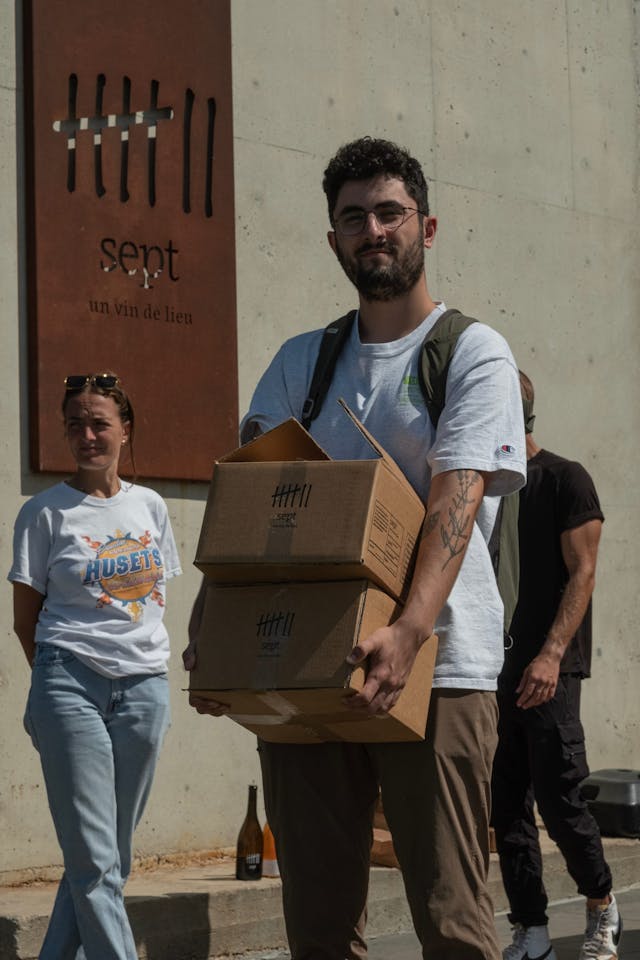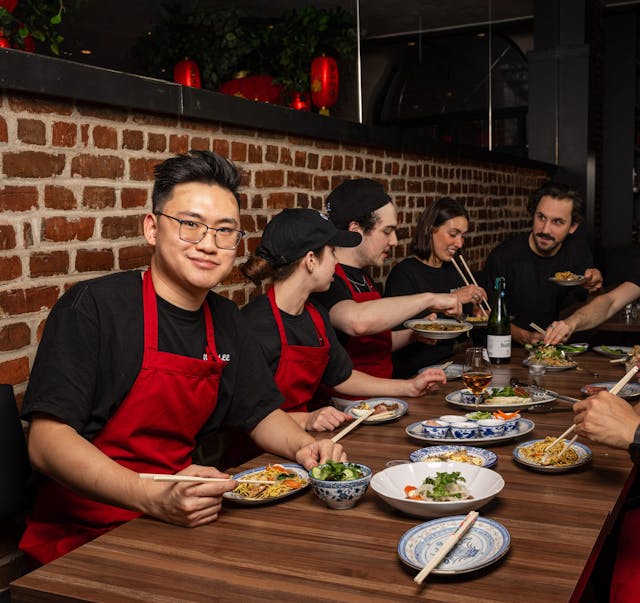Amour Liquide: Expanding ready-to-drink cocktail culture in Canada
The first ready-to-drink cocktail above 7% alcohol in Canada that’s served in one portion, changing the national scene one can at a time.
 Amour Liquide's founders Joël Pelletier & Jean-François Cloutier of Distillerie du St. Laurent and Rose Simard of the online spirits platform 1 ou 2 Cocktails. | Photograph: Nesrine Brikci
Amour Liquide's founders Joël Pelletier & Jean-François Cloutier of Distillerie du St. Laurent and Rose Simard of the online spirits platform 1 ou 2 Cocktails. | Photograph: Nesrine BrikciYou've probably seen it by the cash at the SAQ: Small cans containing negronis, margaritas, old-fashioneds, and espresso martinis.
Carefully curated and concocted, Amour Liquide is a sister project running in parallel to the Rimouski-based Distillerie du St. Laurent, a project following when its co-founders Joël Pelletier & Jean-François Cloutier connecting with Rose Simard of the online spirits platform 1 ou 2 Cocktails.
Sparked by the rise of RTD cocktails in the States, “I saw the culture around them and thought, this is the future of RTD cocktails,” Pelletier says. “At the distillery, we had all the licenses, knowledge, supply chains… we had all the ingredients to make the project happen, but on the brand side, we wanted a completely different approach.”
“We wanted to come up with a way to make cocktails without any compromise on ingredients and put it into a nice, convenient format, but we wanted an ambassador that could connect with consumers. I approached Rose to grow with us, and that friendship just grew from that.”
As opposed to the lower-ABV, RTD drinks found at the SAQ, Amour Liquide's the first ready-to-drink cocktail above 7% alcohol in Canada that’s served in one portion.


Photograph: Kevin Poisson
SHAKE, POUR, LOVE
Like the name implies, Amour Liquide’s pocket-sized, bar-quality cocktails come from a simple love for good ol' standards.
“If you’re in a bar, you’ll see the bottles lining the wall behind the bartender. They'll be sourced from a variety of places, and a bartender will use the ones they think is best for each standard cocktail,” Pelletier explains.
With that in mind, Amour Liquide provided an opportunity for a true collaborative project: In looking for the best possible recipes, each cocktail has ingredients—with some exceptions, like the margarita’s tequila which has to come from Mexico in order to be legally called tequila—has product from Quebec, and none of them contains products exlcusive to Distillerie du St. Laurent.
“The Negroni doesn’t use our own gin—we use KM12 gin from Distillerie du Fjord because of its boreal flavour and (Dunham’s) Val Caudalies’s vermouth—and the espresso martini uses a brew from (the Montreal-based) Café Pista.”


Photograph: Kevin Poisson
EXPANDING CANADA'S COCKTAIL CULTURE
“Amour Liquide isn't a replacement of making cocktails at home, or the experience you have in a bar—Amour Liquide could never replace that. The point is that it’s an extension of that experience in places where you can’t have all the ingredients and equipment on hand, whether that’s in a park or at a chalet,” Pelletier says.
“If you offer something people like in a convenient package, they’ll like it. It’s something you can grab when getting a bottle of wine for a dinner so you’ll have a drink before dinner, or even something you’ll take out camping.”
“It’s a way for people to enter cocktail culture, not in terms of quantity but of quality. It’s an extension of cocktail culture."

NO EASY FEAT
Only relatively recently hitting shelves of the SAQ in November 2022, it took time to launch to gain approval—once it did, it was the first brand in the country to put Canada in step with the rest of the world.
“It would be amazing if you could order small-batch cocktails to go at a bar—you can do that in parts of the world like Europe, but not here. In Quebec, the business model is different; you have to have a proper distillery license, and you have to sell exclusively through the SAQ,” Pelletier says.
Margins are slim with retail sales, which makes living off of a project difficult. Standardization's important (read: no special ingredients pulling from fat washes or sourcing from far-flung reaches of the world) to both keep quality consistent and produce a lot.
Typically, any bar that’s attempted things like cocktails on tap like at Saint-Henri's Bon Délire or bottled like in the Negroni vending machine of Little Italy's Bar Bello, the law states that they have to be made fresh every day. Add in draconian production laws as well as a more-reactive-less-proactive stance of the SAQ, and you have a sizeable challenge to get a provincial crown corporation like the SAQ to accept it.
“We had to show them the trend in the United States, that it was the same level of alcohol per volume as a beer… there’s a lot of hypocrisy around alcohol in Quebec. You can buy beer in any dépanneur or grocery store for the lowest legal price, and the SAQ sells vodka for cheap,” he says.
With that in mind, the RTD scene has become what Amour Liquide sees as the next step in a burgeoning scene.
“Alcohol consumption is decreasing everywhere in world in terms of beer and wine, but spirits are growing. It’s a trend we see everywhere, and the next step we’re seeing is with cocktails. I think the future of spirits consumption is RTDs, and you’re going to see more and more on the market, both low- and high-quality.”



Photograph: Sophie Corriveau
A LOVE OF LEARNING
"I’m doing this because I love learning. Jean-François and I started Distillerie du St. Laurent for example in his basement, two guys distilling alcohol and having fun at a time when the craft spirit movement was taking off in the United States,” Pelletier explains.
“There are a lot of challenges around regulations, but what keeps us moving is the fun that we have with our staff and partners. I think that’s why most people continue working in the bar and restaurant industry do what they do: They like people, they like to share, to enjoy themselves, and share great products while learning new things,” he adds.
“That’s why we’re doing what we do.”

